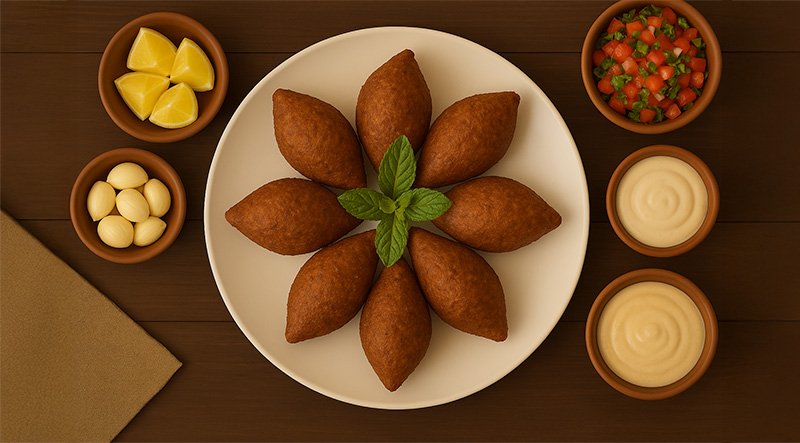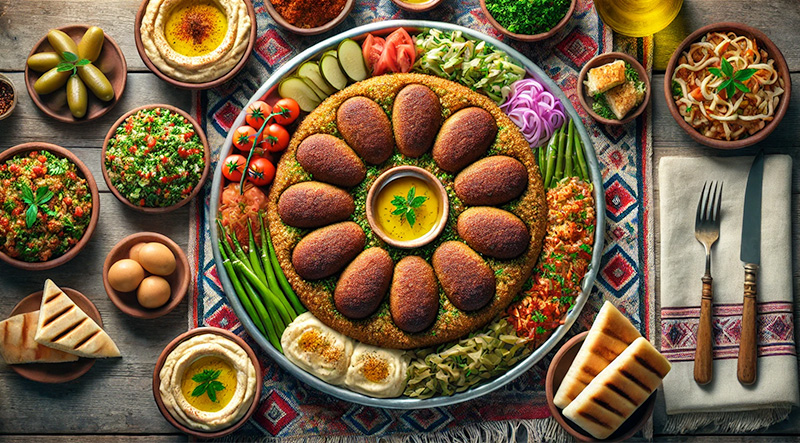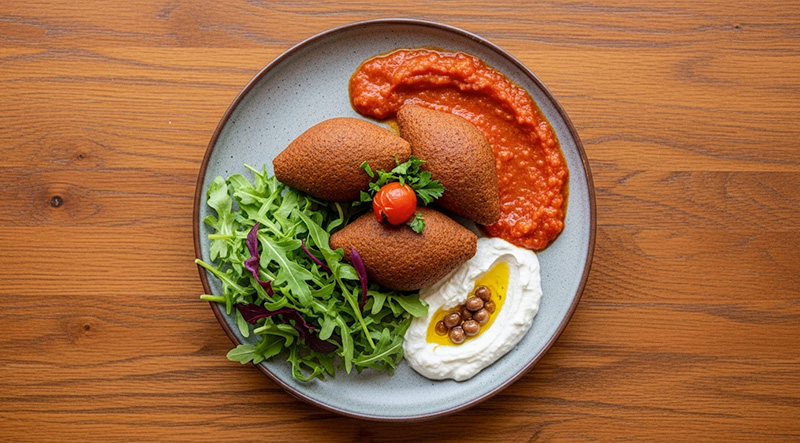Lebanon's irresistible solution to the ideal comfort food is kibbeh, which is crispy on the outside and tender and spiced inside. This well-liked national dish is made with bulgur wheat, finely ground meat, and aromatic herbs to create hearty baked trays or golden-brown torpedoes that are bursting with tradition and flavor. Kibbeh is a rich, savory dish that reflects centuries of Levantine culinary mastery, whether it is served fried, raw, or baked. Every mouthwatering bite is a celebration of Lebanese heritage, making it more than just a meal. Read More...
The History of Kibbeh, Lebanon’s Proud National Dish:
In the heart of Levantine cuisine, no dish holds more cultural, culinary, and emotional significance than Kibbeh, widely recognized as the national dish of Lebanon. With its tender layers of meat, aromatic spices, and the earthy texture of bulgur wheat, Kibbeh is more than just a meal — it is a cherished tradition passed down through generations, a symbol of hospitality, and a proud emblem of Lebanese identity.
Ancient Roots of a Classic:
The origins of Kibbeh can be traced back thousands of years to the Fertile Crescent, where early civilizations like the Phoenicians, Babylonians, and Assyrians cultivated wheat and raised livestock — the very foundation of this dish. Its two essential ingredients, bulgur (cracked wheat) and ground meat (typically lamb or beef), were abundant and easily preserved, making them ideal for rural and urban households alike.
In ancient times, meat was a valuable commodity and often stretched by mixing it with grains and spices. Kibbeh emerged as a smart, flavorful solution — high in protein, economical, and easy to shape and store. Over time, the dish evolved and took root across Lebanon, Syria, Iraq, and Palestine, each region adding its own twist.
Kibbeh and Lebanese Identity:
In Lebanon, Kibbeh became far more than sustenance. It grew into a symbol of family, pride, and culinary skill. The preparation of Kibbeh — especially Kibbeh Nayeh (raw kibbeh) — is seen as an art form and a communal activity, with family members gathering to grind the meat, soak the bulgur, and hand-shape the mixture with love and precision.
Traditionally, Lebanese mothers and grandmothers passed down their signature Kibbeh recipes, each with subtle variations in spice, texture, or technique. Some bake it into hearty casseroles (Kibbeh bil sanieh), others form it into football-shaped croquettes (Kibbeh maklieh) and deep-fry them to crispy perfection. In the Beqaa Valley, coastal towns, and mountain villages, Kibbeh takes on regional flavors — sometimes filled with pine nuts, mint, or even pomegranate molasses.
Ritual and Celebration:
Kibbeh holds a central place in Lebanese holidays, Sunday lunches, religious feasts, and weddings. Preparing Kibbeh is often a family ritual, with women gathering in the kitchen to knead, fill, and shape dozens of pieces while stories, laughter, and memories are shared.
In many Lebanese homes, the preparation of Kibbeh Nayeh — raw minced meat mixed with spices and bulgur — is reserved for special occasions and respected elders, and is always made with the freshest, most trusted ingredients. It’s typically served with olive oil, fresh herbs, and thin bread, and represents trust and tradition at its most intimate.
Global Reach and Variations:
As Lebanese people migrated across the globe, they took Kibbeh with them — introducing it to Europe, the Americas, and Australia. Today, Kibbeh can be found in high-end restaurants, Middle Eastern takeouts, and home kitchens around the world. The dish has also inspired dozens of regional and cultural variations, from Iraqi Kubba Mosul to Armenian Kololak.
While some modern takes incorporate vegetarian fillings, fish, or new cooking techniques, traditional Kibbeh remains a pillar of Lebanese culinary pride. In 2009, Lebanon even attempted to break the world record for the largest plate of Kibbeh, symbolizing its cultural importance.
A Dish That Tells a Story:
Kibbeh is more than meat and grain — it’s a dish that tells stories of migration, resilience, creativity, and kinship. It speaks of Lebanon’s rich history and the strength of its people, who have preserved their culinary traditions through centuries of change and challenge. From its ancient roots to modern dinner tables, Kibbeh continues to unite families, nourish bodies, and celebrate the timeless art of Lebanese cooking.
Prepare the Bulgur:

Make the Filling:
Shape the Kibbeh:

Fry the Kibbeh:
Serve:

Tips for Best Results:
The total preparation and cooking time for traditional Lebanese Kibbeh (Kibbeh Maklieh) is approximately 1 hour and 15 minutes. Preparing the bulgur shell mixture, chopping onions, and cooking the filling takes about 30–40 minutes, depending on your pace and experience. Shaping and stuffing each kibbeh ball is the most time-consuming step, typically requiring 20–30 minutes for a batch serving 6–8 people. Finally, deep-frying the kibbeh in batches takes about 15 minutes. With efficient multitasking, the full dish can be ready to serve in just over an hour, making it a rewarding and festive main course for any occasion.
A single serving of traditional Lebanese Kibbeh (approximately 3 fried pieces) contains an estimated 400–500 calories, depending on the size and fat content of the meat used. The bulgur wheat contributes around 100–120 calories, while the ground beef or lamb in both the shell and filling accounts for 250–300 calories. Frying in oil adds an additional 50–80 calories per serving, depending on how much oil is absorbed. Optional ingredients like pine nuts and side sauces such as yogurt can increase the total by 50–100 calories. Despite being rich and filling, Kibbeh remains a protein-packed, energy-dense dish ideal for celebratory meals.







